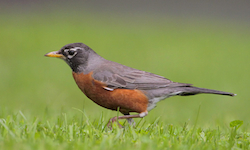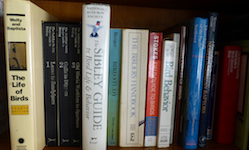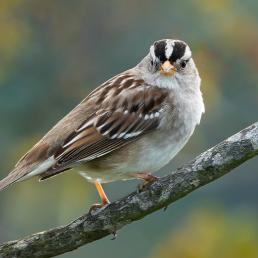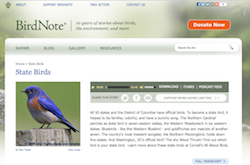

Join BirdNote tomorrow, November 30th!
Illustrator David Sibley and actor H. Jon Benjamin will face off in the bird illustration battle of the century during BirdNote's Year-end Celebration and Auction!
How can we increase diversity in the birdwatching community?
A lesson for high school in two class periods
|  |  | ||
| Summary | Lesson Plan | Resources |
Summary
Birdwatching or "birding" is reportedly one of the fastest-growing hobbies in the United States and as of 2011, there were 47 million birders, ages 16 and older, spying our feathered friends. So why is this hobby not reflective of the communities where we live? According to a 2011 demographic and economic analysis study conducted by the US Fish and Wildlife Service, the average birder or birdwatcher is likely to be around 53 years old, white, and have a better than average income and education. Does this accurately describe the demographics of your students’ community?
Birdwatching is often referred to as a gateway into a larger interest in nature study and conservation. Today birds are facing pressures from pollution, habitat loss, and climate change. The more communities that are engaged in birdwatching and bird conservation, the more we can help relieve the pressures on birds and their habitats. Having more diverse voices in the conservation field will also help to identify more local environmental problems and develop solutions to those problems. As Dr. Lanham says, “Conserving birds and their habitat is a moral mission that needs the broadest and most diverse audience possible to be successful.”
This lesson is meant to be a follow-up to the Birdwatching Through the Lens of Diversity lesson. In these class periods students will view a video of a birdwatching field trip, discuss diversity in their community, and use that knowledge to plan a field trip. Students will develop strategies to advertise widely, attract a very diverse group to the activity, and overcome barriers to participation.
Title: Who's Behind Those Binoculars?
Duration: Two class periods
Setting: Indoors
Subject Areas: Social Studies, Life Science
Grade Level: High School
Lesson Objectives:
* Students will be able to (SWBAT) describe challenges/barriers that limit diversity in birdwatching and nature study in their community.
* SWBAT plan and organize a bird walk, nature hike, or similar activity for your school or community and develop a strategy for including a diverse audience.
How BirdNote is used: a BirdNote video introduces the topic of diversity in birdwatching
Vocabulary:
Birdwatcher - a person who closely observes and tries to identify birds as part of a recreational activity.
Birdwatchers are also known as birders.
Materials:
BirdNote video Behind the Binoculars - Birding with Drew Lanham, with J. Drew Lanham
Flip-chart paper
Lesson Plan
Day One
Motivate: Watch Behind the Binoculars – Birding with Drew Lanham.
* Discuss with students
- In what way is this video different from Dr. Lanham’s Rules for the Black Birdwatcher video?
- How does he address the lack of diversity in birding?
- How does Dr. Lanham connect the diversity of birds to people?
- What were some of the reactions and feelings expressed by the birdwatchers in the video?
Teach: Remind students that birdwatching is reportedly the fastest-growing hobby in the United States, and that as of 2011, there were 47 million birders, ages 16 and older, in the US. According to a 2011 demographic and economic analysis study conducted by the US Fish and Wildlife Service, the average birder or birdwatcher is likely to be around 53 years old, white, and have a better-than-average income and education.
* Ask students to work in groups to discuss barriers that prevent the fastest-growing hobby in the United States from taking flight in their community. Have each group list these barriers and/or limitations on flip-chart paper. The groups should report a summary of their discussions to the rest of the class.
Note: Limitations might include access to equipment, access to natural areas, stereotyping, or lack of knowledge about birdwatching in general.
Day Two
Do the Activity:
* Imagine you are the director(s) of field trips for your local birding association or nature club. Work with a group or with a partner to develop a plan for a birdwatching or nature walk in your community or at a nearby park or nature preserve.
- Develop a strategy that will attract a diverse group of community members. Your strategy should consider multiple elements of diversity: age, sex, race, ethnicity, economics, geography, culture, religion, philosophy, and sexual orientation.
- Think of ways you would market or advertise your bird walk in order to attract a diverse audience. How will you make your bird walk interesting enough to inspire community members to come? For example, you can consider giving out prizes for spotting different kinds of birds.
- Many people may not have a pair of binoculars. How would you solve this problem?
- Develop a flyer/advertisement that can be posted within your community, in newspapers, and on social media.
- Email your plan, marketing strategy, and advertising materials to BirdNote, and we’ll share them with other schools.
Extension Activity: Put your plan into action! Work with a local birding group or nature club to organize a bird walk in your community that attracts a diverse audience.
Conservation Project Ideas: Plant bird-friendly native plants around your school to attract more birds to your community. For ideas on how to make your school bird friendly please visit Audubon Taking Action.
Resources
List of local Audubon Society chapters to contact for bird walks
BirdNote video, Rules for the Black Birdwatcher, with J. Drew Lanham
BirdNote video, Behind the Binoculars - Birding with Drew Lanham, with J. Drew Lanham
BirdNote lesson, Birdwatching Through the Lens of Diversity
Birds, Bird Watching, and the U.S. Economy: from the 2016 National Survey of Fishing, Hunting, and Wildlife-Associated Recreation
US Census Data Mapper
Audubon Guide to North American Birds
BirdNote thanks contributor Drew Lanham for the videos Rules for the Black Birdwatcher and Behind the Binoculars- Birding with Drew Lanham, and for guidance on this lesson plan.
Do you have a lesson plan to share? Check out the guidelines, then download the submission form. Thank you!

